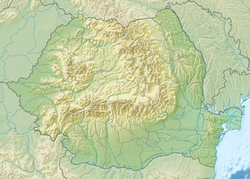Alba Iulia | |
|---|---|
Porta Principalis Dextra Defense wall of the citadel The Union Museum Saint Michael Catholic Cathedral | |
 Location in Alba County | |
| Coordinates: 46°4′1″N 23°34′12″E / 46.06694°N 23.57000°E | |
| Country | |
| County | Alba |
| Government | |
| • Mayor | Gabriel Pleșa[1] (2020–2024) (USR PLUS) |
| Area | |
• Total | 103.65 km2 (40.02 sq mi) |
| Population (2021-12-01)[2] | |
• Total | 64,227 |
| • Density | 620/km2 (1,600/sq mi) |
| Time zone | UTC+2 (EET) |
| • Summer (DST) | UTC+3 (EEST) |
| Website | www |
Alba Iulia (Romanian pronunciation: [ˌalba ˈjuli.a] ; German: Karlsburg or Carlsburg, formerly Weißenburg; Hungarian: Gyulafehérvár [ˈɟulɒfɛɦeːrvaːr]; Latin: Apulum[3]) is a city that serves as the seat of Alba County in the west-central part of Romania. Located on the river Mureș in the historical region of Transylvania, it has a population of 63,536 (as of 2011[update][update]).[4]
During ancient times, the site was the location of the Roman camp Apulum. Since the High Middle Ages, the city has been the seat of Transylvania's Roman Catholic diocese. Between 1526 and 1570 it was the capital of the Eastern Hungarian Kingdom from which the Principality of Transylvania emerged by the Treaty of Speyer in 1570 and it was the capital of the Principality of Transylvania until 1711. At one point it also was a center of the Eastern Orthodox Metropolitan of Transylvania with suffragan to Vad diocese.[5][6] On 1 December 1918, the Union of Transylvania with Romania was declared in Alba Iulia, and Romania's King Ferdinand I and, in 1922 Queen Marie were crowned in the Alba Iulia Orthodox Cathedral.[7]
Alba Iulia is historically important for Romanians, Hungarians, and Transylvanian Saxons. In December 1918, Alba Iulia was officially declared Capital of the Great Union of Romania.[8]
The city administers four villages: Bărăbanț (Borbánd), Micești (Ompolykisfalud), Oarda (Alsóváradja), and Pâclișa (Poklos).[9]
- ^ "Results of the 2020 local elections". Central Electoral Bureau. Archived from the original on 9 October 2020. Retrieved 6 June 2021.
- ^ "Populaţia rezidentă după grupa de vârstă, pe județe și municipii, orașe, comune, la 1 decembrie 2021" (XLS). National Institute of Statistics.
- ^ Encyclopædia Britannica |"Alba-Iulia"
- ^ "Comunicat de presă privind rezultatele provizorii ale Recensământului Populaţiei şi Locuinţelor – 2011" (PDF). Alba County Regional Statistics Directorate. 2 February 2012. Archived from the original (PDF) on 18 April 2013. Retrieved 14 February 2012.
- ^ Maksym Mayorov. Metropolitan of Kiev and other Eastern Orthodox Churches before 1686 (Київська митрополія та інші православні церкви перед 1686 роком ). Likbez. 16 December 2018
- ^ The Metropolitan Cathedral of Cluj Archived 19 April 2019 at the Wayback Machine. Transylvania and Beyond.
- ^ "Alba Iulia". britannica.com. Encyclopædia Britannica. Retrieved 22 June 2022.
- ^ Iaşi desemnat "Capitală istorică", iar Alba Iulia "Capitală a Marii Uniri"
- ^ "State Of Play Report Alba Iulila Municipality" (PDF).








